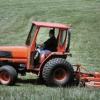 |
Eat Your Veggies: Using Agile Methods to Focus on Healthy Habits Claire Moss shares with us a personal story on how using agile methods helped her family with managing meals and groceries. By using techniques like a Big Visible board, dinnertime for Moss’s family became less of a chore. Remember, nothing ever goes according to plan, but that's true for any healthy team.
|
|
 |
Applying Agile to Distributed Development: A Format for Success Alexey Krasnoriadtsev has been managing globally distributed projects for more than ten years, applying agile methods to improve process efficiency, increase team productivity, and deliver quality products to market faster. With teams split across the globe, he shares with us his approach he's adopted to overcome the communication, process, and quality assurance obstacles facing team members who are a date line and time zone away.
|
|
 |
Do Your Demos Smell? In the agile world, there is a concept of “smells,” or symptoms that things aren’t going well. Introduced by Kent Beck and expanded on by practitioners, smells now describe problems involving adoption, coaching, design, code, and teams. When we see these symptoms, we can identify opportunities to improve.
|
|
 |
Top Five Tips for Starting Agile In this article, Leanne Howard shares her top five tips for teams that are starting agile. Cultivate a culture and environment where people are comfortable. Offer support when team members need it, but allow them to self-organize to perform their tasks and believe they will do it well.
|
|
 |
Implementing Agile in Fortune 1000 Companies David Thach and Rick Rene share what they have learned are the most effective and readily adoptable agile processes, as well as a few techniques to integrate hybrid waterfall approaches. Companies adopt an agile software development framework to become more effective and more efficient, not to become a model of purist agile utopia—which, if attempted, ironically can be immensely costly and detrimental to progress, if not disastrous.
|
|
 |
Mowing the Lawn: An Application of Agility Anthony Akins explains how he used agile methods to modify the way he mowed his lawn. Learn how any project can benefit from using an agile approach and how large projects can be broken down into smaller chunks, each complete and with value.
|
|
 |
Creating a Culture Change with Visual Management Have you heard the old maxim “What gets measured gets done”? Management expert Peter Drucker said it, and here, Bill Donaldson shows us how a smart manager uses visual management to apply measurement to change what gets done.
|
|
 |
Product Backlog Hygiene: Prepare to Be Groomed How do you start with a product backlog when you’re transitioning to agile? In this article, Darin Kalashian shows us how a cross-functional team at the product owner level creates a product backlog.
|
|
 |
Why Agile Teams Need to Know How to Inspect and Adapt “Inspect and adapt” is one of the key agile practices, but not all agile teams perform it well. Here, Raja Bavani has a new spin on an old idea. Let’s learn with Raja as he explains his secret sauce.
|
|
 |
How to Know When Things Are Really Done Do you know when your work is done? Are you sure your feature is done? How about your release? Do you know when it’s done? Leyton Collins has some suggestions for you, your team, and your organization on how to know when things are really done.
|
|
